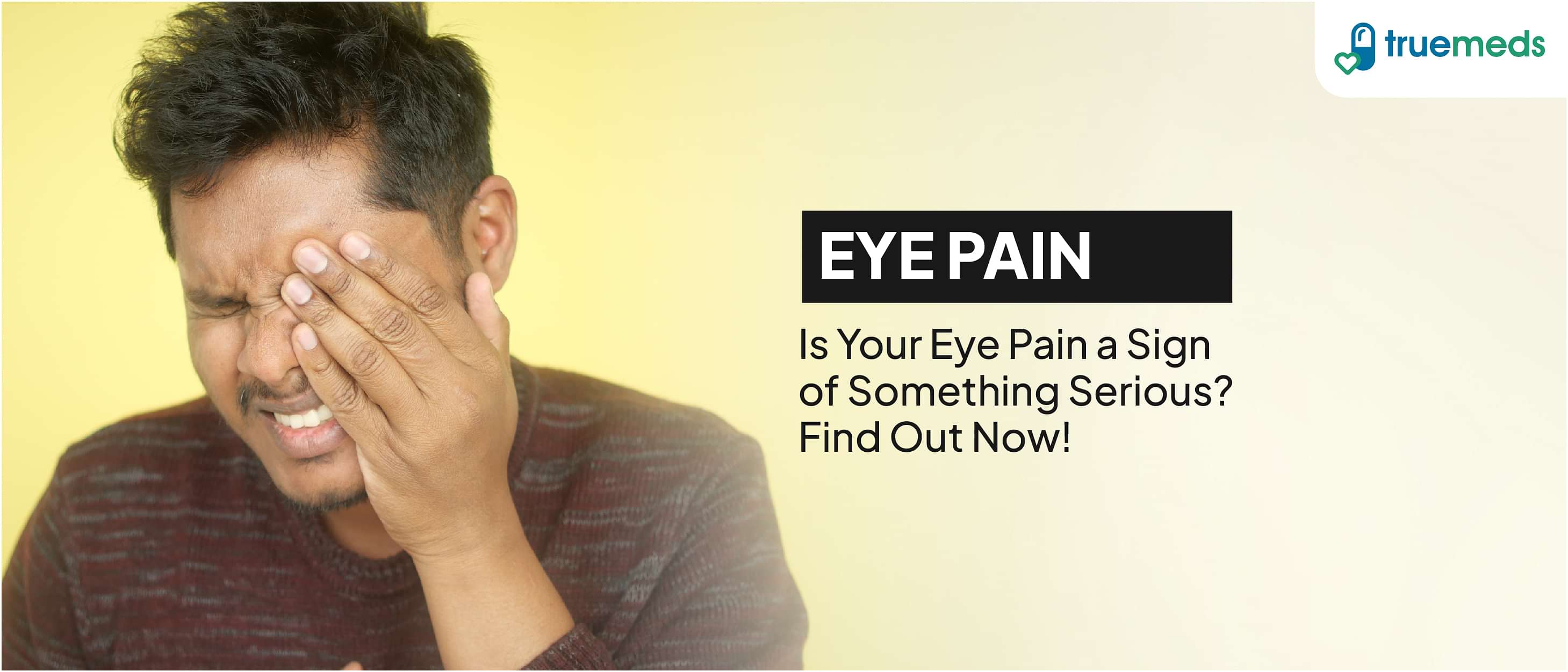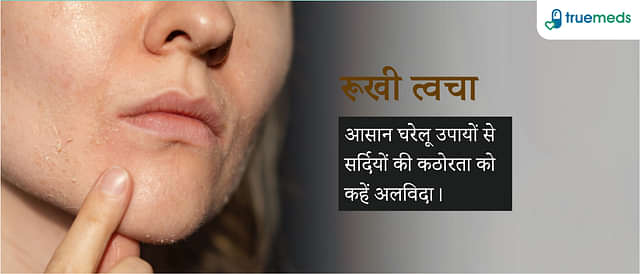Understanding and Treating Eye Pain: Causes, Symptoms, and Solutions
Last updated on : 03 Feb, 2025
Read time : 11 min
What is Eye Pain?
Eye pain, or ophthalmalgia, is discomfort or pain in or surrounding the eyes. It can vary in severity from a slight annoyance to excruciating agony. Numerous things, like as wounds, infections, inflammation, or underlying medical disorders like migraines or glaucoma, might contribute to it. Eye pain frequently manifests as redness, wetness, sensitivity to light, and blurred vision. One or both eyes may be affected by eye pain, depending on the reason, and it may be necessary to see a doctor if the pain is severe or persistent. To avoid any consequences and maintain eye health, proper diagnosis and treatment are crucial.
The sore eye symptoms, including scratching, burning, or itching, indicate that eye pain is on the surface. While sore eyes symptoms, including experiencing aching, gritty, stabbing, or throbbing, indicate that eye pain is within the eye.
Generally, eye pain on the surface can be resolved by just putting in eye drops. While the pain within the eye can be severe and may lead to loss of vision if left untreated. Therefore you should immediately contact an ophthalmologist if your eye pain is accompanied by the following:
- Fever
- Headache
- Unusual sensitivity to light
- A dramatic change in your vision
- Nausea or vomiting
- Entry of any foreign object or chemical splashed in your eye
- Swelling in or around your eyes
- Trouble moving or opening your eyes
- Blood or pus oozing out from your eyes
Who is more likely to experience Eye Pain?
People who spend long hours on digital screens, those with underlying eye conditions like glaucoma or dry eye syndrome, and individuals exposed to allergens or infections are more likely to experience eye pain. Common eye pain reasons include prolonged screen time, infections, and chronic conditions. For eye pain relief, taking regular breaks from screens, using lubricating eye drops, and avoiding allergens can be helpful. Eye pain treatment might involve prescription medications, addressing underlying health issues, or using corrective eyewear. Consulting an eye specialist is essential for proper diagnosis and treatment of persistent or severe eye pain. Also read- Home remedies for eye infection
What parts of your Eye might have Eye Pain?
Eye pain can originate from various parts of the eye, including the cornea, sclera, conjunctiva, and the muscles around the eye. Issues with the cornea, such as scratches or infections, can cause sharp pain, while problems with the sclera or conjunctiva might result in a dull ache or irritation. Additionally, strain or tension in the eye muscles can lead to discomfort. For effective eye pain relief, it is crucial to identify the underlying cause and seek appropriate treatment, which may involve rest, lubricating eye drops, or medical intervention for more severe conditions.
What does Eye Pain feel like?
Eye pain can manifest in various ways, often described as a sharp, throbbing, or burning sensation. Sore eyes might feel achy or strained, making it uncomfortable to keep them open. Common eye pain causes include prolonged screen time, which leads to digital eye strain, infections like conjunctivitis, and conditions such as dry eyes or glaucoma. Allergies and foreign objects in the eye can also contribute to discomfort. In more severe cases, eye pain might be accompanied by blurred vision, redness, or sensitivity to light, signaling the need for professional medical evaluation.
What Causes Eye Pain?
The common eye pain causes are:
1) Foreign object
Any foreign object intruding into your eyes, including eyelashes, a piece of dirt, or makeup, can cause irritation, redness, watery eyes, and pain.
2) Conjunctivitis
Conjunctiva is the thin and clear outermost layer of the eye. Any allergic reaction or infection can inflame and cause itchiness in the eyes. This condition is termed conjunctivitis or pink eye.
3) Contact lens
If the contact lenses you are wearing are not cleaned appropriately in the solution or if you frequently leave contact lenses in your eyes overnight. It can also be a sore eye cause.
4) Corneal abrasion
The cornea is the transparent covering of the iris and pupil, which is susceptible to injuries. Corneal abrasion makes you feel like you have something irritating in your eyes.
5) Injury
Accidental chemical splashes of bleach or any other toxic chemical at the workplace can also be significant eye pain reasons on the outer surface.
6) Blepharitis
It is the inflammation of the oil glands of the inner eyelid. This can also cause eye pain.
7) Stye
Stye is the raised bump on the eyelid due to blepharitis infection. The area around the eye becomes very tender and sensitive to touch. So it can be excruciating if left undiagnosed.
8) Glaucoma
This condition occurs due to high pressure inside the eyes. The nerves connecting to the brain may get damaged and cause nausea, headache, and blindness.
9) Optic neuritis
It is the optic nerve inflammation that an autoimmune disease or a bacterial or viral infection may cause. Optic neuritis is one of the major causes of eye pressure pain that may even lead to vision loss.
10) Sinusitis
Sinusitis is a nasal condition in which the cavities around the nasal passage get inflamed. Sinusitis, if left untreated, can cause pressure behind the eyes that can create pain in one or both eyes.
11) Migraines
Migraine attacks can also be severe eye pain reason.
12) Iritis
The inflammation of the iris can also cause pain deep inside the eye.
Eye Pain Treatment
The treatment for it depends on the reason for the pain. The most common treatments are as follows:
1) Antibiotics
Your doctor will most likely prescribe you antibiotic ointment or drops to treat the pain due to corneal abrasion, iritis, and conjunctivitis.
2) Antihistamines
Antihistamines can relieve eye pain associated with allergies through eye drops, oral medicine, or syrup.
3) Eyedrops
Eye drops can help relieve the pressure building in the eyes during glaucoma.
4) Pain medicines
The medicine for it is prescribed according to the symptoms, severity, and cause of the eye pain.
5) Corticosteroids
Corticosteroids are given to treat eye inflammation due to Iritis and optic neuritis.
6) Glasses
Reading or power glasses can give your eyes a break and time to heal after the regular use of contact lenses.
7) Flushing
Washing your eyes with water or saline water after the invasion of any foreign substance or chemical is the best treatment for a sore eye.
8) Surgery
Surgery is the last line of treatment for the eyes if eye drops or medicines do not repair the damage to the eyes. Mostly, surgery is recommended for patients with glaucoma.
The combination of medications and surgery can help prevent glaucoma from worsening. Laser surgery is done to improve fluid drainage from the eye.
9) Home care
Excessive screen time can cause strain in your eyes. The best way to avoid and treat eye strain is to allow your eyes to rest and keep your eyes covered for a day or more.
Another eye pain treatment at home includes warm compressors. It can help patients with blepharitis or a stye to clear the clogged oil gland or hair follicle and speed the healing process. To give warm compression to your eyes, soak a small towel in hot water, squeeze excess water, fold the towel and gently compress it against your eyes for 5-10 mins.
Besides, keeping your eyes clean, washing your hands before touching your face, avoiding allergic products, and cleaning your contact lenses after every use can help prevent eye pain. To avoid eye pain, you must also put on eyewear as a preventive measure when working with eye irritants, such as chemicals and aerosols.
Read more- Ways to Improve your eyesight to get better vision
What are some common conditions associated with eye pain?
Common conditions associated with eye pain include conjunctivitis, glaucoma, and dry eye syndrome. Conjunctivitis, or pink eye, often leads to sore eyes, redness, and discharge due to infection or allergies. Glaucoma, characterized by increased pressure within the eye, can cause severe pain and potential vision loss if untreated. Dry eye syndrome, where the eyes do not produce enough tears, results in discomfort, irritation, and sore eyes. Other causes include corneal abrasions, uveitis, and optic neuritis, which can all lead to significant eye pain and require prompt medical attention to prevent further complications.
Tests to Diagnose Eye Pain
Diagnosing eye pain involves various tests to identify the underlying cause of sore eyes. A comprehensive eye exam typically includes a visual acuity test, which measures how well you see at different distances, and a slit-lamp examination to check for inflammation or abnormalities. Intraocular pressure tests can detect glaucoma, while dilated eye exams allow doctors to examine the retina and optic nerve. Additional tests like tear film analysis assess dry eye conditions, and imaging tests such as OCT scans provide detailed images of eye structures. These diagnostic tools help pinpoint the exact cause of sore eyes, ensuring appropriate treatment.
Conclusion
Eye pain is often a minor problem and will often go away with rest, splashing your eyes with water, and putting on eye drops. However, if it is severe and accompanied by other symptoms such as fever, headache, nausea, light sensitivity, swelling around the eyes, or trouble opening your eyes, you should immediately contact an ophthalmologist to get the treatment started.
Disclaimer: The information given in this article is true to our best knowledge. Still, we recommend you consult your ophthalmologist before taking any eye medication mentioned in this article.
Frequently Asked Questions (FAQs)
Ocurest, Zaditen, and itis are a few eye drop commonly available to treat watery and inflamed eyes.
Suppose your eye pain is severe and accompanied by other symptoms such as fever, headache, nausea, light sensitivity, swelling around the eyes, or trouble opening your eyes. In that case, you should immediately contact an ophthalmologist.
Rose water has anti-inflammatory properties so it can be used on the inflammatory eye. You can prepare your rose water at home. However, use rose water on the skin first to check the signs of an allergic reaction. Besides, it is not the best remedy for eye pain. It’s better to consult your doctor for appropriate treatment.
Relaxing your eyes and using warm compressors at home can be a useful remedy to treat minor eye pain.
Eye pressure pain is the primary symptom of glaucoma. You should contact your doctor immediately to know about its treatment.
You can use a cold or warm compressor to reduce eye pain immediately. A cold compressor will help relieve the burning or pain from eye strain. While a warm compressor will increase blood circulation, stimulate the oil glands, and relax your eyes.
Hair-covering eyes will not damage your eyes. However, it might obstruct your vision.
Generally, the eye pain followed by headache is due to strain on the eyes. However, it can be an alarming sign of some severe diseases like glaucoma.
A dry eye can be mild to severe and marked by eye pain or discomfort, blurred vision, and increased light sensitivity.
Disclaimer
Our healthcare experts have carefully reviewed and compiled the information presented here to ensure accuracy and trustworthiness. It is important to note that this information serves as a general overview of the topic and is for informational purposes only. It is not intended to diagnose, prevent, or cure any health problem. This page does not establish a doctor-patient relationship, nor does it replace the advice or consultation of a registered medical practitioner. We recommend seeking guidance from your registered medical practitioner for any questions or concerns regarding your medical condition.
Popular Articles
Recommended Articles
Recent Articles
Top-Selling Medicines:
...View more
Top-Selling OTC:
...View more
Subscribe
Registered Office Address
Grievance Officer
Download Truemeds

Contact Us
Our customer representative team is available 7 days a week from 9 am - 9 pm.
v3.7.5
Our Payment Partners


























































